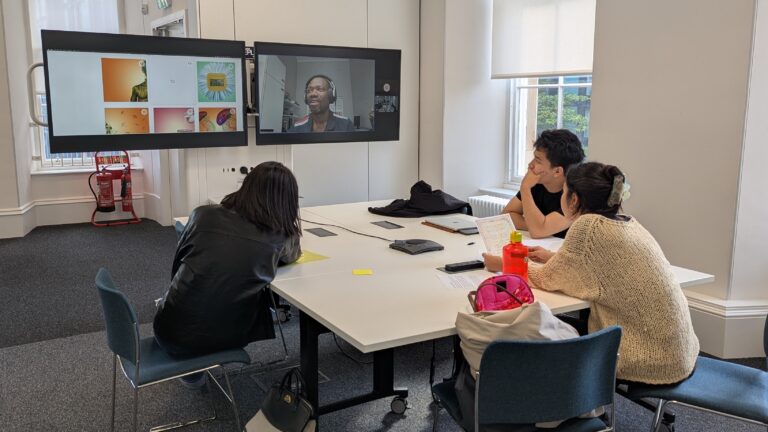This post was originally published on Teaching Matters as part of its Group Work series.
Most of Edinburgh Future Institute’s postgraduate courses are taught in hybrid mode (or ‘fusion’ as it’s known in the Institute). Courses are delivered using an intensive block-teaching model, and group work activities are crucial elements of the learning and teaching. This means that students may spend a large amount of class-time working in hybrid groups, with some students based on campus, and others taking part online. Group members may never meet in person and could be working in very different time zones, which can make group formation and collaboration more complex.
‘Fusion’ frustration
Student feedback from the first years of the Futures Institute’s delivery revealed a high degree of frustration with hybrid group work. Online students often felt invisible, particularly when on-site group-mates forgot to check if they could hear or moved ahead without them. Meanwhile, on-site students struggled to connect with online peers who kept cameras off or missed parts of the discussion.
Yet when hybrid group work worked, students commented it was one of the most rewarding parts of their studies. Online participants brought fresh perspectives that enriched discussions for everyone.
Enabling all students to benefit from hybrid group work meant providing support on two fronts: developing technical competence and fostering inclusive working practices. Students needed to take responsibility for ensuring no one was left out and to appreciate the distinct contributions of on-site and online peers.
Support needed to be provided in the first weeks of the programme to ensure students were ready for hybrid group work as early as possible. Yet feedback indicated that many felt overloaded with information at the start of Semester 1, so any intervention had to feel like something other than just another training session.
Developing the escape room idea
Mary Collacott was asked to design an induction event that would build these essential hybrid skills. Inspired by Heriot-Watt’s Escape Rooms in Education showcase, she proposed something unexpected: a hybrid escape room where teamwork was the only way out.
The context for the escape room activity was a time-travelling adventure, where students were asked to travel back in time to solve clues related to the the Edinburgh Futures Institute building’s history that would help them conquer an army of rogue-AI bots that were determined to take over the planet (i.e. the Terminator goes to University).

Every puzzle was built to compel collaboration between online and on-site players. Each student held different pieces of information, so teamwork wasn’t optional – it was essential.
Along the way, they practised key hybrid working skills, such as:
On-site students:
Online students:
– Communicate effectively with online group members (via audio or Teams chat).
– Answer incoming calls on the Microsoft Teams Room devices.
– Speak clearly into table microphones and arrange AV equipment appropriately.
– Manage and trouble-shoot classroom acoustics challenges.
– Communicate effectively with on-site group members (including directing group members to improve audio issues).
– Log in to Microsoft Teams, Learn and Miro using their UUN.
– Navigate between Teams breakout rooms to join different meetings
Delivery
The escape room sessions were delivered in the first week of Semester 1. Each session began with a brief presentation from one of the Learning Technology team on ‘fusion’ learning. These presentations were given separately to online and on-site students, so that the most relevant points for each audience could be focused on.
The students were then put into their escape room activity groups (with at least one online student in each of the groups). For the next 30 minutes, on-site students ran around the room to find the hidden clues, and brought these back to their online group mates who used this information to solve online puzzles.

The session ended with a plenary on some of the key points that students learned about how to make hybrid group work successful.
Reflections
An escape room was an excellent context for developing group work skills in the first few weeks of Semester 1. Students enjoyed the activity and didn’t feel like they were being bombarded with more information. The session ensured that students had a chance to try out their hybrid group-working skills in a low-stakes environment.
Facilitating the escape room however was intense and required multiple staff to manage both the online and on-site environments. It was difficult to estimate how long the escape room activity would take (some groups sped through the puzzles, while others needed additional support and hints to finish).

For future development we plan to create a print-out with the essential ‘take-aways’ for students (so that some of the key messages of the session are not forgotten, and can be referred to for subsequent hybrid group work activities).
Student feedback
“It was one of the best-prepared and thought-out trainings I’ve done at the University. It was informative engaging, interesting and fun!”
“The very nature of an escape room made it so relevant to what we had to practice: collaboration between online and in-person teams to solve something together. It definitely made us discover the real fusion concept, and it will make us more mindful of how to integrate online students when doing in person work.”
“I appreciated being able to familiarise myself with the fusion technology… while also being compelled to interact with the online students instead of just the on-site ones. Not only was the escape room very fun, it also served as good preparation for our teaching sessions where we would have to engage with online students in class…”

Mary Collacot was a Senior Learning Technology and Design Advisor within the Edinburgh Futures Institute for three years.She is committed to challenging work and educational practices to create a fairer education system for all: promoting ethically grounded learning experiences for the well-being of people and planet. Her research interests include teaching and learning for climate justice; the integration of diverse ways of knowing into understandings of sustainability; and examining transformative and participatory approaches to online, blended and hybrid learning. Mary recently started a new role in Verture, a sustainability charity, as a manager in their training and learning department.

Dr Joe Noteboom is a Senior Learning Technology and Design Advisor, Edinburgh Futures Institute where he supports the design and teaching of Edinburgh Futures Institute’s undergraduate and postgraduate portfolio and the governance of educational technology. He recently completed a PhD in Sociology at the University of Edinburgh, which explored university students’ experiences of data-driven systems and practices.

Emma McAllister is Learning Technology and Design Lead at the Edinburgh Futures Institute, where she has played a central role in developing and supporting the Institute’s distinctive hybrid intensive-block postgraduate programmes. She brings over 15 years of experience in digital and hybrid education, instructional design, and curriculum development across higher education, cultural, and non-profit sectors. At the Futures Institute, she has led programme launch preparations, overseen the creation of hybrid learning spaces, and designed staff development and continuous improvement processes based on student and staff feedback.





